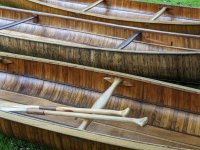I'd like to get better with my single sided correction strokes. At slow speeds in light wind I feel pretty comfortable with what I think is referred to as a Canadian/northwoods stroke (blade is sliced partially forward in the water for correction) but when fighting the wind or putting down more power I really feel like I struggle.
One thing that tends to bother me is the shoulder of my bottom hand. My paddle shaft does not touch the hull during the stroke so this bottom hand is holding the paddling away from the hull during correction and over time starts to hurt my shoulder.
I see many videos of paddlers dragging the paddle shaft along the gunwale or prying off the gunwale for the correction portion of the stroke. This looks easier and more comfortable but it just seems wrong because of the wear on the boat as well as the paddle (both of which are usually composites for me).
So, does your paddle contact the hull during your stroke? If not am I missing something to keep the pressure off my shoulder?
FWIW, I'm center seated in solo canoes of various designs. Sometimes I wonder if the discomfort is coming from the paddle drifting too far behind me before the correction. But, being seated in the center, I feel like I need the blade farther back to get proper correction.
Alan
One thing that tends to bother me is the shoulder of my bottom hand. My paddle shaft does not touch the hull during the stroke so this bottom hand is holding the paddling away from the hull during correction and over time starts to hurt my shoulder.
I see many videos of paddlers dragging the paddle shaft along the gunwale or prying off the gunwale for the correction portion of the stroke. This looks easier and more comfortable but it just seems wrong because of the wear on the boat as well as the paddle (both of which are usually composites for me).
So, does your paddle contact the hull during your stroke? If not am I missing something to keep the pressure off my shoulder?
FWIW, I'm center seated in solo canoes of various designs. Sometimes I wonder if the discomfort is coming from the paddle drifting too far behind me before the correction. But, being seated in the center, I feel like I need the blade farther back to get proper correction.
Alan

